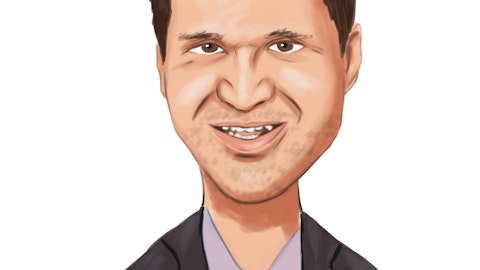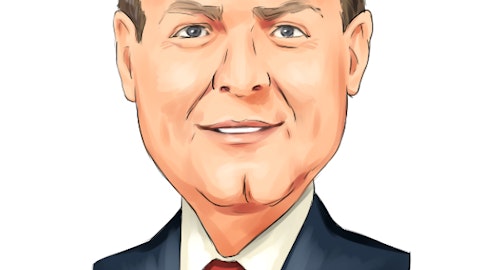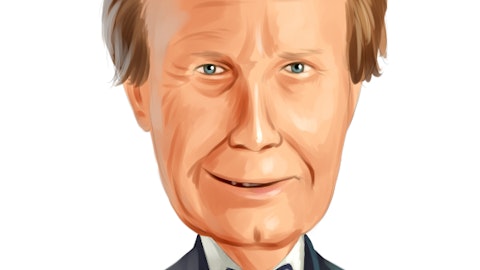Independent Bank Group, Inc. (NASDAQ:IBTX) Q1 2023 Earnings Call Transcript April 25, 2023
Independent Bank Group, Inc. beats earnings expectations. Reported EPS is $1.07, expectations were $0.81.
Operator: Greetings and welcome to the Independent Bank Group’s First Quarter 2023 Earnings Call. As a reminder, this conference is being recorded. I would now like to turn the conference over to your host, Ankita Puri, Executive Vice President and Chief Legal Officer for Independent Bank Group. Thank you. You may begin.
Ankita Puri: Good morning, and welcome to the Independent Bank Group first quarter 2023 earnings call. We appreciate you joining us. The related earnings press release and investor presentation can be accessed on our website at ir.ifinancials.com. I would like to remind you that remarks made today may include forward-looking statements. Those statements are subject to risks and uncertainties that could cause actual and expected results to differ. We intend such statements to be covered by Safe Harbor provisions for forward-looking statements. Please see Page 5 of the text in the release, or Page 2 of the slide presentation for our Safe Harbor statement. All comments made during today’s call are subject to that statement. Please note that if we give guidance about future results, that guidance is a statement of management’s beliefs at the time the statement is made and we assume no obligation to publicly update guidance.
In this call, we will discuss several financial measures considered to be non-GAAP under the SEC’s rules. Reconciliations of these financial measures to the most directly comparable GAAP financial measures are included in our release. I’m joined this morning by our Chairman and Chief Executive Officer, David Brooks, our Vice Chairman, Dan Brooks; and our Chief Financial Officer, Paul Langdale. At the end of their remarks, David will open the call to questions. With that, I will turn it over to David.
David Brooks: Thank you, Ankita. Good morning, everyone, and thanks for joining the call today. For the first quarter we reported a GAAP net loss of $37.5 million or $0.91 per diluted share, which includes the impact of the $100 million legal settlement expense that was previously disclosed on February 27. This onetime payment settles litigation ongoing since 2009, involving Stanford International Bank and related entities that was inherited in connection with our 2014 acquisition of Bank of Houston. The settlement will resolve all current and potential future claims related to the Stanford entities and we believe the settlement could be in our shareholders’ best interests as it enables us to avoid the cost, risk and distraction of protracted litigation.
Excluding this onetime legal expense, adjusted net income for the quarter was $44.1 million, or $1.07 per diluted share. Our core operating business continues to maintain a healthy level of profitability despite the challenges presented by the volatile, macroeconomic and interest rate environment. Our underlying businesses buoyed by a strong balance sheet and a resilient asset quality with non-performing assets of just 32 basis points until assets and net charge also just four basis points annualized. In addition, we continue to maintain robust capital levels with an estimated total capital ratio of 11.85% and a TCE ratio of 7.31%. Those sharper than anticipated funding cost pressures for the first quarter compressed our net interest margin by 32 basis points to 317.
We remain encouraged by the continued repricing of our maturing loans in the mid sevens. This repricing should be a consistent tailwind to our adjusted loan yields, which expanded by 32 basis points in the first quarter to . While accumulating the benefit of higher loan yields will be more gradual, our pursuit of incremental expense discipline is far more immediate. Adjusted non-interest expense for the quarter was at $84.9 million, down $3.5 million from the linked quarter due to the continued realization of benefits from our expense management initiatives. And with that overview, I’ll turn the call over to Paul to get more details on the financials.
Paul Langdale: Thank you, David. And good morning everyone. Starting with the balance sheet this morning, total assets increased by $540 million from the linked quarter to $18.8 billion which was primarily driven by excess liquidity held on balance sheet funded by short term FHLB advances. On balance sheet cash increased to $1.05 billion at quarter end. The company decided to strategically increase our liquidity position out of an abundance of caution and in response to the macroeconomic environment which is consistent with our philosophy of conservatism in gearing the balance sheet. On the liability side, non-interest bearing deposit balances decreased steadily throughout the quarter, as depositors sought higher yielding alternatives for their cash balances.
Quarter end non-interest bearing balances were $4.15 billion down from $4.74 billion at year end 2022. Average non-interest bearing balances during the first quarter were $4.40 billion, and most of the non-interest bearing deposit attrition occurred prior to the end of February as depositor saw higher rates. A portion of these deposits were moved off balance sheet to our wholly owned subsidiary private capital management. During the quarter, approximately $184 million of deposits flowed to private capital management to be deployed in market based liquidity management strategies. And overall AUM and private capital management increased by $235 million, their largest quarter on record. Since these deposits remain in our ecosystem, we expect to have the opportunity to recapture some of these funds on balance sheet in the future.
Slide 20 shows the deposit funding vertical trends. Interest bearing branch deposits were down 3% or $217 million for the linked quarter, for the quarter, which was mostly a result of seasonality and yield seeking behavior early in the year. From February 28 through quarter end, interest bearing branch deposits reverse this trend and increased. The increase of $197 million in brokered CDs was opportunistically executed in February when market rates fell below 5%. The weighted average rate for brokered CDs added in the first quarter was 4.73%. The onset of broader industry events and mid-March meaningfully impacted the pricing and availability of both brokered and non-brokered specialty liquidity. During this time, we often do instead utilize less expensive short term FHLB advances to supplement funding.

jan-huber-J51Wt_AvKbc-unsplash
This included the replacement of $556 million of non-brokered specialty treasury deposit. Public funds balances increased by $101 million from year end. As anticipated, the cost of brokers fund has dropped meaningfully following quarter end, and we have begun to strategically replace maturing FHLB advances with broker funds as appropriate. So far in the second quarter, we have added $162 million broker funds at an average rate of 4.9% and three, six and nine months tenures. Due to this FHLB utilization has begun to decline during the second quarter. As noted on slide 19, adjusted uninsured deposits, which excludes fully collateralized public funds deposits total $5.26 billion or 37.4% of deposits at March 31, 2023. As of quarter end, we have $5.5 billion of immediate borrowing capacity between the FHLB, the Fed and Fed Funds lines, enough to cover all uninsured deposits.
We also maintain access to multiple contingent sources of deposit funding with more than $7 billion of additional capacity, which brings total contingent funding capacity to over $12 billion. Other borrowings increased by $70.5 million during the quarter as a result of the company drawing $100 million on our holding company line of credit to facilitate the repayment of the $30 million tranche of subordinated debt redeemed at quarter end that had moved to floating as well as to facilitate the payment of the legal settlement expense discussed in David’s remarks. Since quarter end, we have repaid $32.5 million on the holding company line of credit, and we expect to retire the remainder of this balance by the end of the third quarter. Regulatory capital levels remain healthy and well in excess of well capitalized minimums with a common equity tier one ratio of 9.67% at tier one ratio of 10.03% and a total capital ratio of 11.85% at quarter end.
Additionally, the TCE ratio remains strong at 7.31%. Moving on to the income statement, net interest income decreased by $13.9 million from the linked quarter and $3.2 million from the first quarter of 2022. NII was impacted by slower loan growth and increased funding costs during the quarter. While net growth was impacted by first quarter seasonality yields continue to benefit from gross production and adjustments in pricing. The average loan yield net of acquired loan accretion and PPP income was 5.33% for the quarter of 32 basis points from the linked quarter. Funding costs as discussed were impacted by the remixing of non interest bearing interest bearing balances during the quarter as well as higher liquidity levels held on balance sheet.
Non-interest in income increased by $1.5 million compared to the linked quarter, which included the recognition of a $318,000 benefit claim related to the BOLI portfolio. Adjusted on interest expense was $84.9 million, a decrease of $3.5 million versus the linked quarter. The primary drivers of the reduction in non-interest expense were lower salaries and benefits expense as well as lower professional fees. Looking ahead, we will continue to maintain expense discipline and explore additional targeted opportunities to strategically reduce non-interest expense through initiatives. These are all the comments I have today. So with that, I’ll turn the call over to Dan.
Dan Brooks: Thanks, Paul. Loans held for investment were $13.6 billion in the first quarter. Loan growth excluding mortgage warehouse and PPP loans totaled $8.5 million or 0.2% annualized for the quarter. New production during the quarter was subdued due to seasonal slowness in the first quarter as well as lower demand across our markets. Despite the lower growth, during the quarter, we originated $599 million of new commitments, and $315 million of which funded during the quarter. We continue to see opportunities in the pipeline, and we continue to underwrite with the same discipline that has guided us through past economic cycles. Average mortgage warehouse purchase loans remained stable at $298 million versus the linked quarter.
Our expectation is for this business to continue to remain flat at current levels. Credit quality metrics continue to strengthen during the quarter. Total non-performing assets decreased to $60.1 million or 0.32% of total assets at quarter end. Other real estate owned decreased to $22.7 due to an impairment of the $1.2 million recognized during the quarter. Net charge offs totaled just four basis point annualized for the first quarter. We continue to see the loan portfolio exhibited resilience in the face of volatile macroeconomic conditions and remain confident in the strength of our credit quality as we enter the second quarter. These are all the comments I have related to the loan portfolio this morning. So with that, I’ll turn it back over to David.
David Brooks: Thanks, Dan. Looking ahead, we remain focused on optimizing our franchise to navigate a complex macroeconomic and banking landscape. We remain encouraged by the continued gross loan production and the repricing of our fixed rate loans and we will continue to focus on opportunities to strategically play both defense and offense on deposit base. While loan production was seasonally lower in Q1, we’re seeing solid opportunities in the pipeline and still expect to grow loans at 4% to 5% annualized rate for the remainder of the year. In the second quarter, we will continue to optimize our expense base for the current environment. We expect to achieve targeted expense reduction opportunities that will allow us to incrementally manage the run rate down over the course of ’23. Thank you for taking the time to join us today. We’ll now open line to questions. Operator?
See also 25 Highest Paying Jobs in the World Without a Degree and 13 Best Medical Stocks To Invest In.
Q&A Session
Follow Independent Bank Group Inc. (NASDAQ:IBTX)
Follow Independent Bank Group Inc. (NASDAQ:IBTX)
Operator: Thank you. At this time we’ll be conducting a question and answer session. Our first question comes from the line of Brad Milsaps with Piper Sandler. Please proceed with your question.
Brad Milsaps: Hey, good morning.
David Brooks: Good morning, Brad.
Brad Milsaps: Thanks for taking my questions. I was just curious, Paul, a lot of movement with the balance sheet at the end of the quarter. I’d be curious if you’d be able to provide us sort of spot deposit rates, and maybe even spot loan rates. And maybe how that might inform your margin outlook is as you think about sort of all the moving parts as we kind of move to the next couple quarters.
Paul Langdale: Sure, Brad happy to provide some color on that. On the earning asset side, our loan yields are coming on in the mid 7s. We’ve reliably seen that for the last couple of months. And we expect that pace to continue based on what we see in the pipeline. On the deposit side, the marginal funding that we’re adding to our balance sheet is just under 5%. We’ve tried to manage that rate relative to the liquidity available in the market and relative to our strategy. And so that’s our expectation to hold funding at that level, depending on the trajectory of course of monetary policy.
Brad Milsaps: Okay, maybe just drilling down a little bit further. I mean, you had total deposit cost of I think around 170 basis points interest bearing costs were a little over 2.4%. If you thought about where those numbers kind of moved to at the end of the quarter, given all the moving parts are you seeing the pace of the beta slowdown? Or would you expect something similar to what you saw in the first quarter?
Paul Langdale: The betas in the first quarter, Brad were driven significantly by the non-interest bearing remixing trends that we saw in the interest bearing. So adding those interest bearing funds. We didn’t expect the magnitude of non-interest bearing makeshift in the first quarter. It was really driven by accelerated yield seeking behavior that coming out of the fourth quarter really accelerated into January and February. But most of the NIM pressure I think has happened in the first quarter and following quarter end we’ve seen a stabilization in funding costs, leads us to anticipate that NIM will bottom out in Q2 and expanding in Q3 and beyond as earning asset yields begin to climb. So it’s hard to give an exact range given the dynamism and the environment. But we certainly don’t anticipate the kind of betas and compression in Q2 that we saw in Q1.
Brad Milsaps: And Paul, just the kind of final follow up would you expect any federal loan beta around 38% in the quarter, obviously, you’ve been talking about the repricing characteristics of your loan book for a while. Do you expect that to continue to step up and more heavily weighted and one quarter versus another, we’re just going to kind of be this sort of gradual climb as we move through the year?
Paul Langdale: It’s weighted heavier and the back half of the year and ’23 than in the front half of the year. We have seasonal slowness, usually, especially in the first quarter. So the amount of bulk repricing that we get in the first quarter is reliably less than in the back half of the year when we see the most growth. I will say that we certainly do expect given our loan growth guides to see those earning assets especially loan yields pick up and the more production we have, and the more net growth we have to know that will impact the yield.
Brad Milsaps: Okay, great. Thank you guys. I’ll hop back in queue.
David Brooks: Thanks Brad.
Operator: Thank you. Our next question comes from the line of Brandon King with Truist Securities. Please proceed with your questions.
Brandon King: Hey, good morning.
David Brooks: Good Morning Brandon.
Brandon King: See, I had another question on deposits. I know before is the goal to match deposits with loan growth but want to get updated thoughts and your outlook for where you see deposits trending for the remainder of the year?





